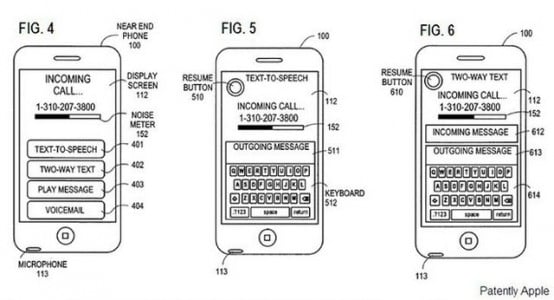Patents, patents and more patents. Apple has been there before posted recently a patent, but this time for a new text-to-speech and speech-to-text system for iDevices. Apple designed this new system to solve problems where users can't talk on the phone because they are in an area where the noise is too loud or another problem where the user doesn't have a smartphone and can't read text messages . Apple found a fairly simple solution to these problems: turning words into letters and turning letters into words. When the user cannot speak because of the noise, the terminal records the words, converts them into text and sends them to the other party.
According to a new Apple patent application that was published this morning by the US Patent and Trademark Office, future iPhone's are likely to provide end users with effective new ways of communicating in both noisy environments like a restaurant or even during a quiet office meeting without stirring a mouse. The system involves using new text-to-speech and speech-to-text converters as well as providing a means of sending prerecorded notifications to the caller if you're unable to speak when answering your phone. I think that many will appreciate these new features and only hope that Apple could get these to market in good time.
The other party can receive everything as text on the phone, or they can receive the text and the iPhone can read it itself. The process is similar in the case of those who call from a fixed line a user with an iPhone who cannot speak, the user writes a message on the phone and the message is transformed by the iPhone and is recited to the user on the other end of the line. Of course, everything also works based on a system that detects ambient noises and transforms speech into text and vice versa. Practically, this system would greatly facilitate conversations, but I, for one, am interested in seeing how Apple will implement it.
A smartphone user may sometimes have to make or answer a phone call in a noisy environment. Noise could interfere with a telephone conversation to a degree that the conversation is no longer intelligible to either conversing party. A user in the noisy environment may try to scream into the phone over the noise, but the screaming and the noise may render the voice signal unintelligible at the other end.
In another scenario, it may be inconvenient for a user to talk on a phone. For example, users may be in a meeting and don't want to draw attention to themselves by speaking on the phone. The users may try to whisper into the phone, but the whispering may render the conversation unintelligible. The users may choose to send a text message to the other party, but the other party may be on a landline where texting is unavailable, or may not have a texting plan. It could be frustrating to conduct a telephone conversation when the environment is noisy or the circumstance is inappropriate for a user to speak.

















